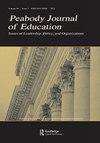The Distribution of School Resources in the United States: A Comparative Analysis Across Levels of Governance, Student Subgroups, and Educational Resources
Q2 Social Sciences
引用次数: 6
Abstract
ABSTRACT Levels of governance (the nation, states, and districts), student subgroups (racially and ethnically minoritized and economically disadvantaged students), and types of resources (expenditures, class sizes, and teacher quality) intersect to represent a complex and comprehensive picture of K-12 educational resource inequality. Drawing on multiple sources of the most recent available data, we describe inequality in multiple dimensions. At the national level, racially and ethnically minoritized and economically disadvantaged students receive between $30 and $800 less in K-12 expenditures per pupil than white and economically advantaged students. At the state and district levels, per-pupil expenditures generally favor racially and ethnically minoritized and economically disadvantaged students compared to white and economically advantaged students. Looking at nonpecuniary resources, minoritized and economically disadvantaged students have smaller class sizes than their subgroup counterparts in the average district, but these students also have greater exposure to inexperienced teachers. We see no evidence that district-level spending in favor of traditionally disadvantaged subgroups is explained by district size, average district spending, teacher turnover, or expenditures on auxiliary staff, but black and Hispanic spending advantage is correlated with the relative size of the black and Hispanic special education population.美国学校资源的分布:治理水平、学生分组和教育资源的比较分析
摘要治理水平(国家、州和地区)、学生分组(种族和族裔少数以及经济弱势学生)和资源类型(支出、班级规模和教师质量)相互交叉,代表了K-12教育资源不平等的复杂而全面的情况。根据最新可用数据的多个来源,我们从多个维度描述了不平等。在国家层面,种族和族裔少数族裔和经济弱势学生的K-12支出比白人和经济优势学生少30至800美元。在州和地区层面,与白人和经济优势学生相比,每个学生的支出通常有利于种族和族裔少数族裔和经济弱势学生。从非学校资源来看,少数族裔和经济弱势学生的班级规模比平均地区的小组学生小,但这些学生也更容易接触到缺乏经验的老师。我们没有看到任何证据表明,有利于传统弱势群体的地区一级支出可以用地区规模、平均地区支出、教师流动率或辅助人员支出来解释,但黑人和西班牙裔的支出优势与黑人和西班牙裔特殊教育人口的相对规模相关。
本文章由计算机程序翻译,如有差异,请以英文原文为准。
求助全文
约1分钟内获得全文
求助全文
来源期刊

Peabody Journal of Education
Social Sciences-Education
CiteScore
2.20
自引率
0.00%
发文量
43
期刊介绍:
Peabody Journal of Education (PJE) publishes quarterly symposia in the broad area of education, including but not limited to topics related to formal institutions serving students in early childhood, pre-school, primary, elementary, intermediate, secondary, post-secondary, and tertiary education. The scope of the journal includes special kinds of educational institutions, such as those providing vocational training or the schooling for students with disabilities. PJE also welcomes manuscript submissions that concentrate on informal education dynamics, those outside the immediate framework of institutions, and education matters that are important to nations outside the United States.
 求助内容:
求助内容: 应助结果提醒方式:
应助结果提醒方式:


